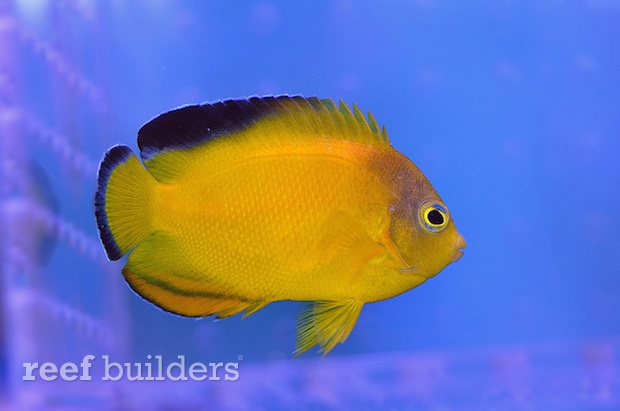Centropyge heraldi is an unassuming yellow dwarf angelfish with a huge can of worms just waiting to be opened. When you do, you’ll probably want to break down and cry in confusion. Apart from the standard yellow dwarf angelfish, C. heraldi comes in numerous “variants” that until now remain unexplainable. This new individual from Vanuatu has a black-edged tail that we have never seen before, and adds to the growing number of freaky variations that this one troublesome species has to offer.

In the normal true to type form, C. heraldi is a boring plain coloured fish. Males may have a very obscure and faint reticulated pattern or green and orange on the tail, dorsal and anal fin as seen in this individual. It is also not uncommon to find specimens with a small dark patch just behind the eye. This individual above has a very tiny patch.
What’s interesting is this fish is capable of producing many variants that we can only assume are that of C. heraldi. Obviously genetic work needs to be done and tissue samples collected from every single form and compared against the species.

The commonest non-standard form of C. heraldi involves specimens having a black edged soft dorsal fin like the one above. There is also usually a small silver or blue outline along the black portion. This form is not rare and is often collected from Vanuatu. In the past, the name Centropyge woodheadi was appointed to this form, but it has become invalid and C. woodheadi is now just a variation of C. heraldi. Interestingly, the black edge can disappear fully or partially in the aquarium, much like certain aberrant Centropyge.

Yet another crazy variation that sometimes appear are these double black finned C. heraldi. The long tapering fins suggests that the fish is a large male, and the top black portion on the dorsal is from the “woodheadi” variant. What’s curious to note is the severe darkening on the lower anal fin. In mature males, we often see orange and green scrawling but seldom do they appear so black. What’s going on here? Are these individuals tainted with blood from another Centropyge species?

Then we have individuals like this, with double coloured fins and a discontinued crown. The elongated body profile and the crown suggests genetic input from C. bicolor, but other than that everything is pretty much C. heraldi. Surely the influence of C. bicolor would be strong enough and not leave the entire body solid yellow, but this isn’t the case here. So the hybrid theory for this particular individual is still floating around, unconfirmed. A tissue sample from such specimens would really be useful in narrowing down the identity crisis.

Perhaps the most severe aberration of C. heraldi are those known as “dusky heraldi” that come out of Cebu as well as Vanuatu. In the past, these were thought to be hybrids with Centropyge nox, but aquarium specimens were documented to lose the black partially or completely. Another interesting thing to note is the presence of a huge range of intermediates in this “dusky” patterning. Some like the ones above are nearly completely black, while others have the black localised and cleanly demarcated on either the tail, fins or certain parts of the head.

In this particular dusky heraldi above, you can see that the smokiness is very light and restricted to the fins, while the face is particularly smudged in black. This form is sometimes called the panda variety by fish exporters. Note the squiggly green and orange maze like pattern on the anal fin. So what does this all mean. Are they all Centropyge heraldi? They have to be connected to that species someway or another, but exactly what’s going on remains unclear. As mentioned before, a fin clipping from these individuals would unlock the secret to the heraldi problem.
Now let’s back track and take a look at the C. heraldi with the black edging on the tail again. The dorsal fin contains the black trim which is typical of the “woodheadi” variation, but the black-edge on the tail is a new feature that we have not seen in any of the other C. heraldi morphs before. Notice how the head is also a little bit dusky which is not so evident in the photo, but more clearly seen in the video.
Before we can even find out what’s really going on with C. heraldi, another individual such as this pops up with a brand new variation to confuse us even further. Perhaps one day we will know if these are all indeed the same fish, with a penchant for wacky variations. For now, we’ll just have to make do and enjoy the plethora of different forms that nature has to offer. A big thank you to Jimmy Ma of Hong Kong for sharing with us another one of his fish.



